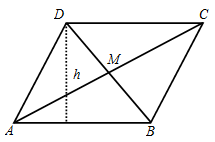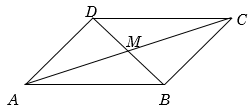Geometry
Quadrilaterals
Parallelogram
A Quadrilateral in which opposite side are parallel is called a parallelogram.
- Opposite sides are equal and parallel, opposite angles are equal.
- Each diagonal divides the parallelogram in two congruent triangles and diagonals bisect each other.
- Sum of any two adjacent angles is 180°.
- Angle bisectors of vertices form a rectangle

Area of the parallelogram = Base \( \times \) height = \(AB \times h\)
or area = \(AB \times ADsin\theta \), where \(\theta \) is the angle between \(AB\) and \(AD\).
Example 18: In a parallelogram two adjacent sides are 11 and 13 cms, if length of one of the diagonal is 20, find the length of the second diagonal.
Solution: The following diagram shows the parallelogram whose sides are 11 and 13. \(AC\) is 20 or \(AM =10\), suppose \(MD = a\).

Using Apollonius Theorem
\({11^2} + {\rm{ }}{13^2} = {\rm{ }}2{\rm{ }}\left( {{{10}^2} + {a^2}} \right) \Rightarrow a\) = \(\sqrt {45} \)
\(BD = 2a = 2\sqrt {45} \)